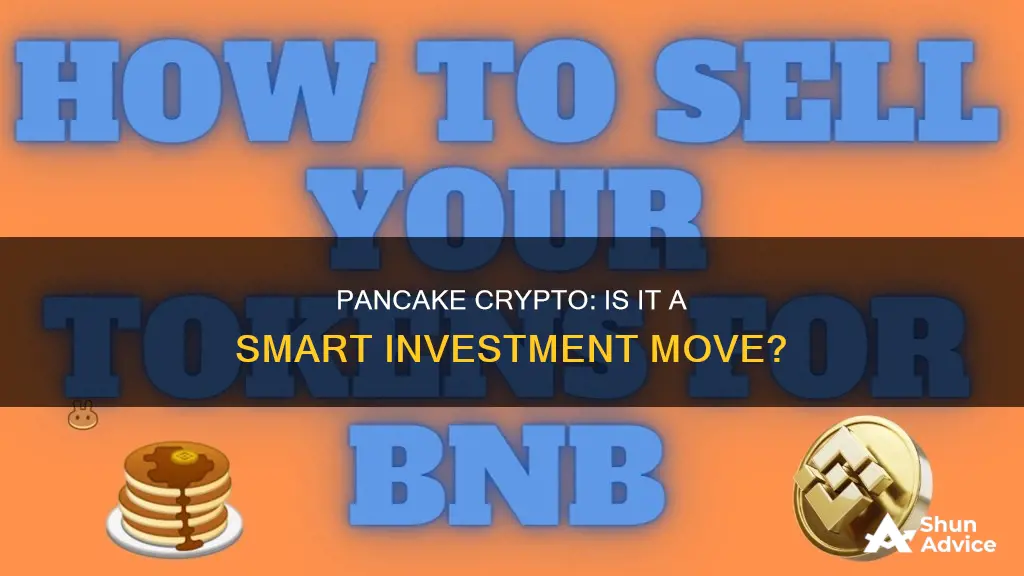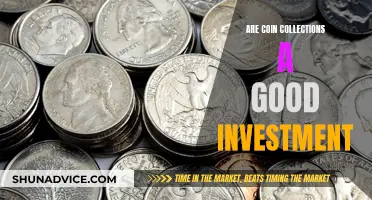
PancakeSwap (CAKE) is a decentralised exchange (DEX) on the Binance Smart Chain (BSC). It is a leading DEX in the crypto market, with over $5.6 billion in staking. CAKE is the native token of PancakeSwap, and there are several ways to make money from investing in it. However, it is important to remember that the cryptocurrency market is extremely volatile, and investors should always do their own research before investing.
What You'll Learn

PancakeSwap's high yield staking potential
PancakeSwap is a decentralised exchange (DEX) on the Binance Smart Chain (BSC). It is one of the biggest DEXs built on BSC and has proven to be a secure and legitimate platform. PancakeSwap offers a high yield staking potential for its users.
Staking on PancakeSwap involves holding tokens in a pool, similar to holding money in an interest-bearing savings account. Users can stake their tokens in PancakeSwap's Syrup Pools, which offer an Annual Percentage Yield (APY) that differs from pool to pool. The APY can be calculated using the built-in rewards calculator, which projects the rate of return after taking compounding interest into account.
There are two types of staking on PancakeSwap. The first involves staking Liquidity Provider (LP) tokens in farms, and the second is staking BEP-20 tokens in Syrup Pools. By providing liquidity to the pool, users are rewarded with transaction fees that are proportional to the size of the liquidity pool and are granted LP tokens. These LP tokens can then be staked in PancakeSwap's farms to earn additional yield in the form of CAKE tokens, which can be harvested at any time.
The benefits of staking on PancakeSwap include the ability to earn passive income, with sky-high yields that often exceed 100% APY. Staking also contributes to network security and gives users governance rights within the community. Additionally, stakers may enjoy reduced transaction fees and the ability to compound their returns through automatic restaking.
However, there are also risks associated with staking on PancakeSwap. The volatility of the cryptocurrency market can significantly impact the value of the initial stake and rewards earned. Regulatory changes could also affect the investment, and many staking protocols require a fixed lock-up period for assets. Smart contract failures and central power play by a few big players are also potential risks to consider.
Overall, PancakeSwap's high yield staking potential offers a solid opportunity for investors to earn passive income and compound their returns. However, it is important to carefully consider the risks and conduct thorough research before investing in any cryptocurrency project.
Minting Money: Are US Mint Coins a Smart Investment?
You may want to see also

CAKE's triple-digit percentage yields
PancakeSwap (CAKE) is a decentralised finance (DeFi) token and exchange (DEX) on the Binance Smart Chain (BSC). It is one of the largest crypto market makers, providing liquidity to users.
CAKE offers triple-digit percentage yields to its users, which can be achieved through liquidity provision and staking.
Liquidity Provision
CAKE users can provide liquidity to the PancakeSwap DEX by pledging their tokens to facilitate crypto-to-crypto trading. This is a form of market-making, where users facilitate trades by providing liquidity for various tokens and earning trading fees in return. The trading fees are dynamic and determined by community vote.
The more liquidity provided, the greater the potential earnings. This is because the spread between bid and ask prices is larger for less liquid assets, resulting in higher potential commissions for liquidity providers.
Staking
CAKE holders can also stake their tokens to earn rewards. Staking involves holding tokens in a digital wallet, with the option to earn additional tokens as rewards. The staking rewards on PancakeSwap are substantial, often exceeding 60% per year. These rewards are funded by various sources, including fees for validating CAKE transactions and payments from blockchain developers for listing their tokens on the exchange.
Additionally, CAKE offers automatic restaking, where any rewards earned are automatically put back into the staking pool, further compounding the user's returns. This can lead to even higher yields, sometimes as high as 83%.
Risks and Considerations
While CAKE's triple-digit percentage yields are attractive, it is important to consider the risks. The rate of CAKE emission, or coin creation, is relatively high, which can lead to inflationary pressures and dilute the value of existing tokens. Therefore, it is crucial for investors to monitor the token's market cap and supply dynamics to make informed decisions.
Furthermore, as with any investment, there is always the risk of losing money. Cryptocurrency markets are highly volatile, and the value of tokens can fluctuate significantly.
In conclusion, CAKE offers lucrative opportunities for users through liquidity provision and staking, resulting in triple-digit percentage yields. However, investors should carefully consider the risks and conduct thorough research before investing.
Vara Coin: A Smart Investment Decision?
You may want to see also

CAKE's price history and future predictions
Price History
CAKE, the native token of PancakeSwap, was launched on 29 September 2020 at $1.37 and struggled to surpass its launch price in its first few months. CAKE experienced its biggest rally in 2021, with the cryptocurrency skyrocketing to its all-time high of $44.18 on 30 April 2021. After the market correction in May and a challenging summer, CAKE climbed again to $26.59 on 26 August 2021, before falling to $17.85 on 8 September 2021.
The volatile nature of the cryptocurrency market was further exhibited in CAKE's price action throughout 2021 and 2022. The token's price fluctuated between $10 and $26, ending 2021 at $11.77. The downward trend continued into 2022, with CAKE dropping below $5 as the crypto market crashed due to the depegging of the UST stablecoin and the collapse of the associated LUNA cryptocurrency. The token ended 2022 at $3.18, losing over 70% of its value for the year.
Future Predictions
The future predictions for CAKE vary, with some sources offering optimistic outlooks while others remain cautious or bearish. Here is a summary of the predictions:
- CoinCodex's short-term prediction for 2023 suggested CAKE could rise to $4.08 by 5 March and further increase to $5.26 by 31 March.
- DigitalCoinPrice's forecast expected CAKE to average $7.34 in 2023, reach $13.59 in 2025, and achieve $40.83 in 2030.
- PricePrediction was bullish, anticipating CAKE to rise from an average of $5.59 in 2023 to $12.52 by 2025. Their prediction for 2030 was $73.54.
- Wallet Investor took a bearish stance, projecting CAKE to drop to around $2.96 by the end of February 2024.
- Changelly, as of 20 September 2024, indicated that CAKE could reach a maximum of $3.44 in 2024, with an average trading price of $6.20.
- PricePrediction.net's forecast suggested CAKE could trade between $4.24 and $5.03 in 2025, with a potential high of $31.94 by 2030.
- CoinCodex's long-term prediction placed CAKE between $5.16 and $8.36 by 2030.
It is important to remember that price predictions, especially for volatile assets like cryptocurrencies, can often be incorrect. The highly unpredictable nature of the crypto market makes it challenging to provide accurate long-term estimates. As such, analysts and algorithm-based forecasters may not always be correct in their projections.
Stash and Dogecoin: A How-to Guide for Investors
You may want to see also

PancakeSwap's status as a leading decentralised exchange
PancakeSwap is a decentralised exchange (DEX) on the Binance Smart Chain (BSC). It is the largest automated crypto market maker and provider of trading liquidity on the BSC. PancakeSwap's status as a leading decentralised exchange is underpinned by its strong growth potential, competitive transaction fees, and high liquidity.
PancakeSwap users have staked more than $5.6 billion on this decentralised exchange, compared to a market value of just $4.983 billion. This suggests that the token is a bargain compared to peers such as Uniswap, which has a total value locked (TVL) that outpaces its market cap by a factor of 3.3. PancakeSwap's fees are also much lower than Uniswap's, at just 0.2% for users who use liquidity in their pools. These fees are not paid in Ether, allowing for more transactions and higher profit margins for traders and investors.
PancakeSwap's smart contracts enable automatic restaking, meaning that every CAKE a user earns can be put back into the staking pool, earning further "interest". This setup can lead to yields as high as 83% instead of the regular 65% or so. The platform also has amazing wallet integration and supports popular wallets like WalletConnect, MathWallet, TokenPocket, TrustWallet, and even MetaMask.
PancakeSwap has the largest number of daily users of any decentralised application (dApp) and the fourth-highest market volume. Its high daily volume is great news for investors looking for a token to stake. It is effortless to get in and out of Cake, and most tokens in the cryptocurrency space cannot make this claim.
However, it is important to remember that all cryptocurrency investments carry risks. Binance, which PancakeSwap is built on, is currently facing a probe by the Justice Department over allegations of insider trading and market manipulation. The outcome of this investigation could negatively affect Cake and the entire BSC.
Siacoin Crypto: A Smart Investment Decision?
You may want to see also

CAKE's liquidity and market volume
CAKE is the native token of PancakeSwap, a decentralised exchange (DEX) on the Binance Smart Chain (BSC). It is used to fill the dex's liquidity pools, which are collections of crypto tied to a smart contract. This helps a coin or token be bought and sold for a price that reflects its current market value.
PancakeSwap users have staked more than $5.6 billion on the DEX, compared to a market value of just $4.983 billion. This suggests that the token is a bargain compared to peers such as Uniswap, which has a total value locked (TVL) that outpaces its market cap by a factor of 3.3. PancakeSwap's TVL increased dramatically in 2021 due to lower network costs, branding, and the introduction of new and creative services.
PancakeSwap's TVL reached a peak of US$7.8 billion on 3 May 2021. As of May 2022, the platform's TVL was at around US$4 billion. The trading volume of PancakeSwap (CAKE) was $57,483,782.60 in the last 24 hours, representing a -4.40% decrease from the previous day and signalling a recent fall in market activity.
PancakeSwap's monthly volume and market share in terms of DEX volume have both increased since the v3 launch at the start of Q2 (April 2023). Total trading volume in Q2 grew 77% QoQ, while Q3 volume grew 11.2% compared to Q1. Meanwhile, the market share in terms of DEX volume grew 110% from Q1 to Q2, and Q3's market share grew 92% compared to Q1.
PancakeSwap's liquidity providers can earn significantly more fees on the same amount of liquidity. Liquidity providers can choose fee tiers, customise price ranges, create non-fungible liquidity positions, and concentrate capital, providing more flexibility and potential to maximise earnings.
Dash Coin: A Smart Investment Choice?
You may want to see also
Frequently asked questions
PancakeSwap is a decentralised exchange (DEX) on the Binance Smart Chain (BSC). It was launched in September 2020 and is similar to Uniswap on the Ethereum blockchain.
The PancakeSwap token is called CAKE. It is used to fill the dex's liquidity pools, which help buy and sell crypto at a price that reflects its current market value.
PancakeSwap has lower fees than its rivals and is more liquid. It also has a large user base and is considered one of the most secure DEXs.
There are three main ways to make money with PancakeSwap: buying and holding CAKE tokens, staking CAKE, and providing liquidity for crypto-to-crypto trading on the PancakeSwap DEX.
It is hard to say. Cryptocurrency markets are extremely volatile, and it is difficult to predict what a token's price will be in the short or long term. It is important to do your own research and never invest more money than you can afford to lose.







